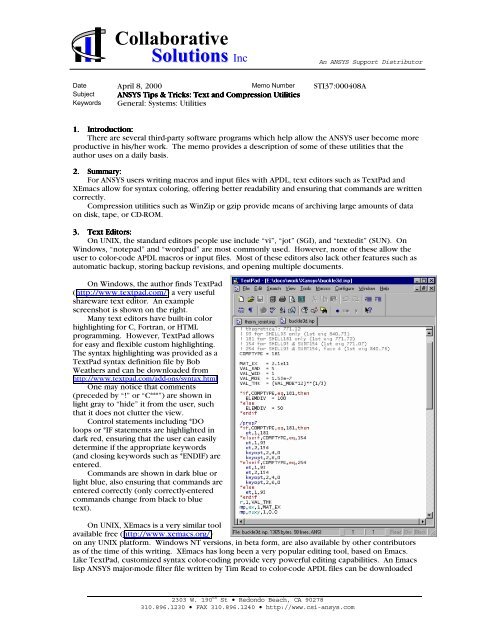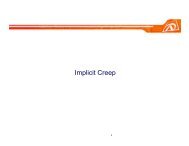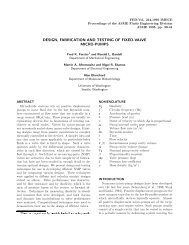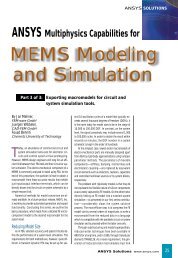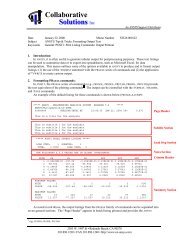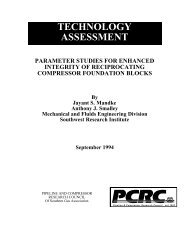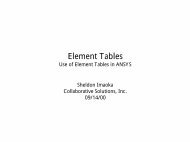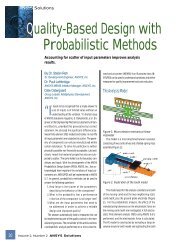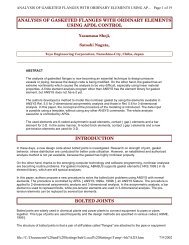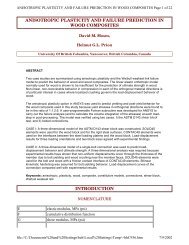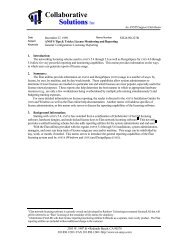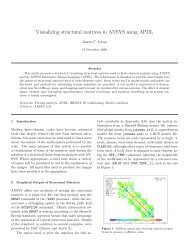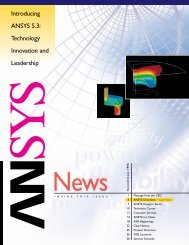ANSYS Tips & Tricks: Text and Compression Utilities - ANSYS Users
ANSYS Tips & Tricks: Text and Compression Utilities - ANSYS Users
ANSYS Tips & Tricks: Text and Compression Utilities - ANSYS Users
Create successful ePaper yourself
Turn your PDF publications into a flip-book with our unique Google optimized e-Paper software.
Collaborative<br />
Solutions Inc<br />
Date April 8, 2000 Memo Number STI37:000408A<br />
Subject <strong>ANSYS</strong> <strong>ANSYS</strong> <strong>Tips</strong> <strong>Tips</strong> & & <strong>Tricks</strong>: <strong>Tricks</strong>: <strong>Text</strong> <strong>Text</strong> <strong>and</strong> <strong>and</strong> <strong>Compression</strong> <strong>Compression</strong> <strong>Utilities</strong><br />
<strong>Utilities</strong><br />
Keywords General: Systems: <strong>Utilities</strong><br />
2303 W. 190 th St • Redondo Beach, CA 90278<br />
310.896.1230 FAX 310.896.1240 http://www.csi-ansys.com<br />
An <strong>ANSYS</strong> Support Distributor<br />
1. 1. Introduction:<br />
Introduction:<br />
Introduction:<br />
There are several third-party software programs which help allow the <strong>ANSYS</strong> user become more<br />
productive in his/her work. The memo provides a description of some of these utilities that the<br />
author uses on a daily basis.<br />
2. 2. Summary:<br />
Summary:<br />
For <strong>ANSYS</strong> users writing macros <strong>and</strong> input files with APDL, text editors such as <strong>Text</strong>Pad <strong>and</strong><br />
XEmacs allow for syntax coloring, offering better readability <strong>and</strong> ensuring that comm<strong>and</strong>s are written<br />
correctly.<br />
<strong>Compression</strong> utilities such as WinZip or gzip provide means of archiving large amounts of data<br />
on disk, tape, or CD-ROM.<br />
3. 3. <strong>Text</strong> <strong>Text</strong> Editors:<br />
Editors:<br />
On UNIX, the st<strong>and</strong>ard editors people use include “vi”, “jot” (SGI), <strong>and</strong> “textedit” (SUN). On<br />
Windows, “notepad” <strong>and</strong> “wordpad” are most commonly used. However, none of these allow the<br />
user to color-code APDL macros or input files. Most of these editors also lack other features such as<br />
automatic backup, storing backup revisions, <strong>and</strong> opening multiple documents.<br />
On Windows, the author finds <strong>Text</strong>Pad<br />
(http://www.textpad.com/) a very useful<br />
shareware text editor. An example<br />
screenshot is shown on the right.<br />
Many text editors have built-in color<br />
highlighting for C, Fortran, or HTML<br />
programming. However, <strong>Text</strong>Pad allows<br />
for easy <strong>and</strong> flexible custom highlighting.<br />
The syntax highlighting was provided as a<br />
<strong>Text</strong>Pad syntax definition file by Bob<br />
Weathers <strong>and</strong> can be downloaded from<br />
http://www.textpad.com/add-ons/syntax.html<br />
One may notice that comments<br />
(preceded by “!” or “C***”) are shown in<br />
light gray to “hide” it from the user, such<br />
that it does not clutter the view.<br />
Control statements including *DO<br />
loops or *IF statements are highlighted in<br />
dark red, ensuring that the user can easily<br />
determine if the appropriate keywords<br />
(<strong>and</strong> closing keywords such as *ENDIF) are<br />
entered.<br />
Comm<strong>and</strong>s are shown in dark blue or<br />
light blue, also ensuring that comm<strong>and</strong>s are<br />
entered correctly (only correctly-entered<br />
comm<strong>and</strong>s change from black to blue<br />
text).<br />
On UNIX, XEmacs is a very similar tool<br />
available free (http://www.xemacs.org/)<br />
on any UNIX platform. Windows NT versions, in beta form, are also available by other contributors<br />
as of the time of this writing. XEmacs has long been a very popular editing tool, based on Emacs.<br />
Like <strong>Text</strong>Pad, customized syntax color-coding provide very powerful editing capabilities. An Emacs<br />
lisp <strong>ANSYS</strong> major-mode filter file written by Tim Read to color-code APDL files can be downloaded
Collaborative<br />
Solutions Inc<br />
2303 W. 190 th St Redondo Beach, CA 90278<br />
310.896.1230 FAX 310.896.1240 http://www.csi-ansys.com<br />
An <strong>ANSYS</strong> Support Distributor<br />
from the eGroups/ONElist website at http://www.onelist.com/files/xansys/emacs/. One must be a<br />
subscriber to the X<strong>ANSYS</strong> mailing list in order to access the above URL 1<br />
.<br />
In XEmacs, one can also create various “rules” to provide for easier readability for macros – for<br />
example, the contents of every *IF statement can be automatically indented to separate those<br />
sections from the rest of the code (as shown in the <strong>Text</strong>Pad example above).<br />
There are numerous other features 2<br />
of <strong>Text</strong>Pad <strong>and</strong> XEmacs which make them very convenient<br />
editors. Both allow users to save backup copies of edited files, even to a special “backup” directory<br />
so as not to clutter up one’s working directory. Customization of font faces <strong>and</strong> colors as well as<br />
scripting provide for very powerful text editors, h<strong>and</strong>y for editing APDL macros, input files, C or<br />
Fortran code, or HTML pages. <strong>Text</strong>Pad also allows for easy DOS-UNIX conversion -- changing LF<br />
(line-feeds) to CR (carriage returns) <strong>and</strong> vice-versa.<br />
Two other free editors for UNIX which also have many features, including syntax highlighting,<br />
are vim/gvim, available at http://www.vim.org, <strong>and</strong> nedit, downloadable from<br />
http://www.nedit.org. 3<br />
4. 4. File File <strong>Compression</strong> <strong>Compression</strong> <strong>Compression</strong> <strong>Utilities</strong>:<br />
<strong>Utilities</strong>:<br />
The <strong>ANSYS</strong> database <strong>and</strong> results files (“jobname.db” <strong>and</strong> “jobname.rst”) can become very large.<br />
While many users save the ASCII log <strong>and</strong>/or input files <strong>and</strong> macros, one may also want to keep the<br />
binary database <strong>and</strong> results files for future use. The author recommends “zip” <strong>and</strong> “gzip” utilities for<br />
this purpose -- usually, a filesize reduction of 30-40% can be obtained.<br />
While the “zip” method of compression is often associated with the PC platform, “zip” is also<br />
available on UNIX. One can find source code or compiled versions of “zip” for DOS or any UNIX<br />
platform. 4<br />
When using “zip”, the comm<strong>and</strong>-line argument is:<br />
zip –9 zipfile.zip <br />
In the above example, one compresses “” to “zipfile.zip” with maximum compression<br />
(indicated by the argument “-9”). For zipping up files <strong>and</strong> directories, one can use<br />
zip –9r zipfile.zip <br />
where the “-r” option signifies “recursive” zipping (i.e., zip up directories <strong>and</strong> their contents,<br />
including subdirectories).<br />
A companion tool is “unzip” used to uncompress zip files:<br />
unzip –d zipfile.zip<br />
This unzips “zipfile.zip” <strong>and</strong> extracts the contents to the current working directory.<br />
For Windows, WinZip is a very useful shareware tool (http://www.winzip.com/) to provide a<br />
GUI for the zip routine. WinZip works within Windows Explorer, so one can easily zip/unzip files<br />
<strong>and</strong> directories to send to colleagues. While the author is not familiar with a good GUI zip program<br />
on UNIX, he recommends the use of WinZip on the Windows platform. (There are other similar<br />
Windows zip tools such as PkZip)<br />
Another very useful compression tool is “gzip”, also available on UNIX <strong>and</strong> DOS. Unlike “zip”,<br />
which compresses multiple files/directories into ONE zip file, “gzip” compresses each file<br />
individually. This may or may not be useful to a user. For example, a user may want to keep many<br />
<strong>ANSYS</strong> files on disk. Instead of opening one large zip file, he/she may want to selectively<br />
uncompress certain sets of files. In this regard, “gzip” is very h<strong>and</strong>y. Also, used in conjunction with<br />
“tar” (also available both on DOS <strong>and</strong> UNIX), one can “gzip” directories <strong>and</strong> files to ONE tar/gzip file.<br />
To gzip individual files, the following comm<strong>and</strong> may be used:<br />
gzip –9r <br />
As in the case of “zip”, the “-9” option indicates “maximum compression” <strong>and</strong> the “-r” argument<br />
designates recursive action. Note that there is no “gzipfile.gz” specified. This is because “gzip”<br />
individually compresses files. All compressed files will have a “.gz” extension automatically<br />
appended to the filename.<br />
1<br />
Details on the X<strong>ANSYS</strong> mailing list can be viewed on the last page of this document.<br />
2<br />
Not every useful feature of <strong>Text</strong>Pad or XEmacs can be covered, so readers are encouraged to download <strong>and</strong><br />
evaluate the usefulness of these text editor for themselves.<br />
3<br />
Information provided courtesy of A. Danial at TRW.<br />
4<br />
As of the time of this writing, zip 2.2 <strong>and</strong> unzip 5.2 are the latest versions.
Collaborative<br />
Solutions Inc<br />
2303 W. 190 th St Redondo Beach, CA 90278<br />
310.896.1230 FAX 310.896.1240 http://www.csi-ansys.com<br />
An <strong>ANSYS</strong> Support Distributor<br />
To decompress files with “gzip”:<br />
gzip –d *.gz<br />
The “-d” option will “decompress” all files ending with the “.gz” extension (as indicated by the<br />
wildcard “*.gz” argument). The “.gz” filename extension will automatically be removed after<br />
uncompression, thus preserving the uncompressed file in its original state.<br />
When archiving multiple files/directories to a single “gzip” file, one can use tar comm<strong>and</strong>s as<br />
well, both available for DOS <strong>and</strong> UNIX. For example, one can use:<br />
tar cf - | gzip –9c > filename.tgz<br />
The above comm<strong>and</strong> first uses “tar” (Tape ARchiving) to create a tar file. The “cf” arguments (note<br />
that there is NO dash preceding these arguments) tells “tar” to “c” create a “f” file. The “-“ option<br />
means to send it to st<strong>and</strong>ard output. The pipe comm<strong>and</strong> “|” redirects the st<strong>and</strong>ard output to “gzip”.<br />
For the “gzip” arguments, “-9” is for maximum compression, <strong>and</strong> “-c” is for taking st<strong>and</strong>ard input <strong>and</strong><br />
output as the file arguments. The redirect symbol “>” redirects the “gzip” output to a file called<br />
“filename.tgz”. One can use “filename.tar.gz” instead to indicate the compression methods, but<br />
because the tar/gzip is used commonly, “.tgz” is also a recognized, shorter file extension.<br />
To decompress the tar/gzip file, use:<br />
gzip –dc filename.tgz | tar xvf -<br />
Similar to above, “-d” is for decompress, <strong>and</strong> “-c” tells “gzip” to send output to st<strong>and</strong>ard output. This<br />
is piped to “tar” which extracts (“x” argument) from st<strong>and</strong>ard output (“f” <strong>and</strong> “-“ arguments). The<br />
“v” argument is added to indicate “verbose” operation, so “tar” will tell the user which files have<br />
been un-tarred to the current working directory.<br />
Note that the Windows program “WinZip” can extract “gzip” <strong>and</strong> “tar” files, also recognizing the<br />
“.tgz” extension. WinZip cannot create “gzip” or “tar” files, however.<br />
There are numerous websites where one can obtain “zip”, “gzip”, or “tar”, either as source code<br />
or compiled binaries. Since there are too many to list, the reader is directed to internet search<br />
engines to find the appropriate sites for his/her platform.<br />
5. 5. Conclusion/Recommendations:<br />
Conclusion/Recommendations:<br />
There are many useful utilities, both freeware <strong>and</strong> shareware, to enhance one’s productivity.<br />
Specifically, this memo covered some text editing programs <strong>and</strong> compression utilities which the<br />
author finds quite useful. The text editing programs enhance one’s ability to write APDL macros <strong>and</strong><br />
input files while the compression utilities help with storage of <strong>ANSYS</strong> data.<br />
In closing, the author recommends that, after evaluating shareware programs, if the reader finds<br />
them useful, they should pay the appropriate cost for these software. Only by supporting these<br />
shareware developers will useful utilities continue to exist, so it is in everyone’s best interest to<br />
support shareware developers – if one finds a shareware program useful enough to use regularly, one<br />
should pay the small cost associated with the software. Shareware costs tend to be less than $50, so<br />
it is also not a big price to pay for these productivity-enhancing tools.<br />
__________________________<br />
Sheldon Imaoka<br />
Collaborative Solutions, Inc. (LA Office)<br />
Engineering Consultant
Collaborative<br />
Solutions Inc<br />
<strong>ANSYS</strong> <strong>ANSYS</strong> Tip Tip of of the the Week Week<br />
Week<br />
2303 W. 190 th St Redondo Beach, CA 90278<br />
310.896.1230 FAX 310.896.1240 http://www.csi-ansys.com<br />
An <strong>ANSYS</strong> Support Distributor<br />
“<strong>ANSYS</strong> Tip of the Week” (TOTW) is provided for customers of Collaborative Solutions, Inc.<br />
(CSI) with active TECS agreements, distributed weekly in Adobe Acrobat PDF format via email.<br />
Unless otherwise stated, information contained herein should be applicable to <strong>ANSYS</strong> 5.4 <strong>and</strong> above,<br />
although usage of the latest version (5.6 as of this writing) is assumed. <strong>Users</strong> who wish to<br />
subscribe/unsubscribe or to view older TOTW archives can visit<br />
http://www.csi-ansys.com/tip_of_the_week.htm<br />
Corrections, comments, <strong>and</strong> suggestions are welcome <strong>and</strong> can be sent to operator@csiansys.com<br />
[they will be distributed to the appropriate person(s)]. While CSI engineers base their<br />
TOTW on technical support calls <strong>and</strong> user questions, ideas on future topics are appreciated. <strong>Users</strong><br />
who wish to submit their own TOTW are encouraged to do so by emailing the above address for<br />
more information.<br />
X<strong>ANSYS</strong> X<strong>ANSYS</strong> Mailing Mailing List<br />
List<br />
The X<strong>ANSYS</strong> mailing list is a forum for questions <strong>and</strong> discussions of the use of <strong>ANSYS</strong>. As of<br />
04/00, there are more than 1000 subscribers with topics ranging from Structural, Thermal, Flotran,<br />
to Emag analyses, to name a few. <strong>Users</strong> are encouraged to subscribe to evaluate the usefulness of the<br />
mailing list for themselves. Also, either (a) using the mail program to filter [xansys] messages or (b)<br />
using the “digest” option to receive one combined email a day is strongly recommended to minimize<br />
sorting through the volume of postings.<br />
This list is for *ALL* users of the <strong>ANSYS</strong> finite element analysis program from around<br />
the world. The list allows rapid communication among users concerning program<br />
bugs/ideas/modeling techniques. This list is NOT affiliated with <strong>ANSYS</strong>, Inc. even<br />
though several members of the <strong>ANSYS</strong>, Inc. staff are subscribers <strong>and</strong> regular<br />
contributors.<br />
To SUBSCRIBE: send blank email to xansys-subscribe@onelist.com<br />
To unsubscribe send blank email to xansys-unsubscribe@onelist.com<br />
Archived on http://www.infotech.tu-chemnitz.de/~messtech/ansys/ansys.html<br />
ANOTHER archive on http://www.eScribe.com/software/xansys/<br />
(A poor archive is also at http://www.onelist.com/archives.cgi/xansys)<br />
CSI CSI <strong>ANSYS</strong> <strong>ANSYS</strong> <strong>ANSYS</strong> Technical Technical Support, Support, Training, Training, & & Mentoring<br />
Mentoring<br />
Collaborative Solutions, Inc. is committed to providing the best customer support in our<br />
industry. Three people will be devoted to technical support from 8:00 a.m. to 5:00 p.m. PST every<br />
working day. CSI customers with active TECS (maintenance) agreements may contact CSI by any of<br />
the following ways:<br />
Phone: 760-431-4815 WWW: http://www.csi-ansys.com<br />
Fax: 760-431-4824 FTP: ftp://ftp.csi-ansys.com<br />
E-mail: firstname.lastname@csi-ansys.com<br />
CSI Engineers:<br />
Karen Dhuyvetter Greg Miller Sean Harvey Alfred Saad<br />
Bill Bulat Sheldon Imaoka David Haberman Mike Rife<br />
CSI believes strongly in the value of training <strong>and</strong> mentoring to help make customers successful<br />
using <strong>ANSYS</strong>. Training classes are usually 2-3 days in duration <strong>and</strong> provide instruction on various<br />
topics, including structural nonlinearities, heat transfer, <strong>and</strong> dynamics. Mentoring sessions involve<br />
working with a CSI engineer one-on-one on specific projects. These sessions help reinforce<br />
applicable subject matter covered in training classes or help ensure that the customer is using <strong>ANSYS</strong><br />
most efficiently <strong>and</strong> effectively.<br />
Training class schedules are posted at: http://www.csi-ansys.com/training.htm<br />
Please contact your account manager for more details on training, mentoring, consulting, <strong>and</strong><br />
other services CSI provides.


